CONTENTS
- Vesuvius Area
- How to Escape From the Labyrinths of Portici?
- Living With Vesuvius in Ercolano
- Torre del Greco Waiting to be Destroyed Again
- What Other Treasure Lies Below Ercolano?
- View of Vesuvius From the Forum of Pompeii
- Allen Alda From Scientific American Frontiers
- Rod Norland From Newsweek
- Canadian Broadcasting Company
- High School Students From Plinio Seniore
- An Eyewitness of the 1944 Eruption
- Vesuvius at School
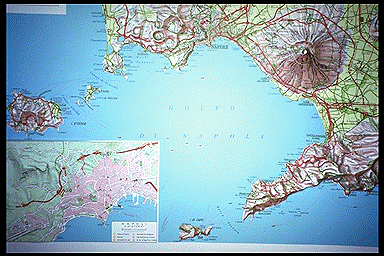 Vesuvius is surrounded by about 3 million people, which includes about
one million living in the city of Naples. Naples is also surrounded by
the
Phlegrean Fields on the west which pose another volcanic treat.
Vesuvius is surrounded by about 3 million people, which includes about
one million living in the city of Naples. Naples is also surrounded by
the
Phlegrean Fields on the west which pose another volcanic treat.
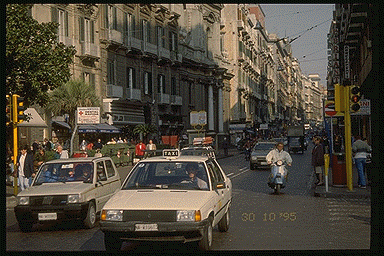 Via Liberta in Portici is only 5 kilometers from the crater of
Vesuvius, with
the population density of about 15,000 inhabitants per square kilometer.
In the event of an emergency people will most likely panic because they
will feel of being trapped.
Via Liberta in Portici is only 5 kilometers from the crater of
Vesuvius, with
the population density of about 15,000 inhabitants per square kilometer.
In the event of an emergency people will most likely panic because they
will feel of being trapped.
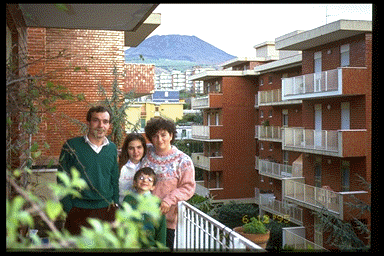 The family Bronzuto lives in Ercolano and from their terrace have a
splendid
view of the volcano. There are many buildings like this one abusively
constructed by speculators too close to the volcano.
The family Bronzuto lives in Ercolano and from their terrace have a
splendid
view of the volcano. There are many buildings like this one abusively
constructed by speculators too close to the volcano.
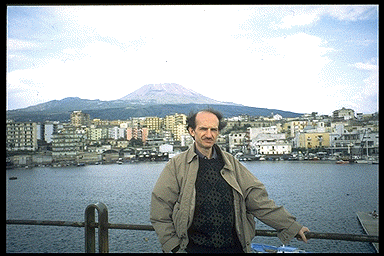 Torre del Greco is the largest city of the Vesuvius area, with about 104,000
inhabitants. It was destroyed several times after the Pompeii eruption in
79 and the last time in 1794 when the lava flow reached the sea, 7
kilometers from the crater. The town shown in the background was built
on this lava after 1794.
Torre del Greco is the largest city of the Vesuvius area, with about 104,000
inhabitants. It was destroyed several times after the Pompeii eruption in
79 and the last time in 1794 when the lava flow reached the sea, 7
kilometers from the crater. The town shown in the background was built
on this lava after 1794.
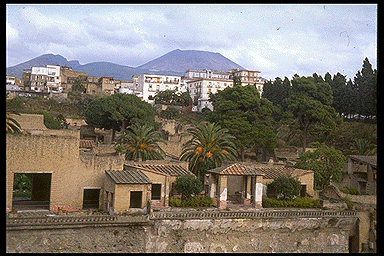 Herculaneum was covered with more than 10 meters of pyroclastic debris
during the 79 eruption. About 5,000 people lived in this resort town and
most apparently escaped. The town was rediscovered by chance in 1711,
but it was not until 1738 that the Bourbon King Charles II initiated the
excavation. The view from the sea shows that some part of the town is still
buried under the modern town of Ercolano (white buildings in the
background).
Herculaneum was covered with more than 10 meters of pyroclastic debris
during the 79 eruption. About 5,000 people lived in this resort town and
most apparently escaped. The town was rediscovered by chance in 1711,
but it was not until 1738 that the Bourbon King Charles II initiated the
excavation. The view from the sea shows that some part of the town is still
buried under the modern town of Ercolano (white buildings in the
background).
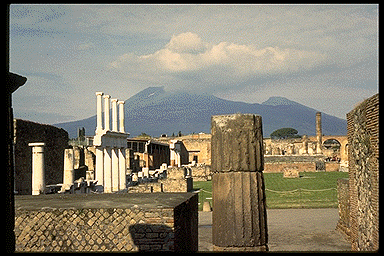 The Greco-Roman town of Pompeii was buried under several meters of
pyroclastic flows and tephra during the 79 eruption. It too was
rediscovered by chance and Charles II ordered excavations in 1748, when
it became hard to loot for treasure in the ruins of Herculaneum. Pompeii
was a very prosperous commercial town of about 20,000 people where
many Romans adopted the
Greek culture. This view of Vesuvius was taken from the ruins of the
forum.
The Greco-Roman town of Pompeii was buried under several meters of
pyroclastic flows and tephra during the 79 eruption. It too was
rediscovered by chance and Charles II ordered excavations in 1748, when
it became hard to loot for treasure in the ruins of Herculaneum. Pompeii
was a very prosperous commercial town of about 20,000 people where
many Romans adopted the
Greek culture. This view of Vesuvius was taken from the ruins of the
forum.
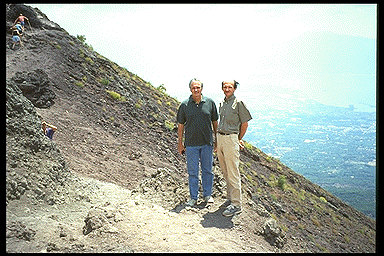 In 1994 the crew of Scientific American Frontiers (host Allen Alda) came to
film our Vesuvius activities. This picture with Allen was taken on the edge
of the southern crater rim of the volcano. The view is towards Torre
Annunziata and the sea.
In 1994 the crew of Scientific American Frontiers (host Allen Alda) came to
film our Vesuvius activities. This picture with Allen was taken on the edge
of the southern crater rim of the volcano. The view is towards Torre
Annunziata and the sea.
 The Canadian Broadcasting Company, Societe' Radio Canada, came to film
GVES activities in the Vesuvius area and produced a 15-minute
documentary called "Le Vesuve"
for world-wide distribution. Shown in this picture are Flavio Dobran and
Giuseppe Luongo with the television crew on Vesuvius.
The Canadian Broadcasting Company, Societe' Radio Canada, came to film
GVES activities in the Vesuvius area and produced a 15-minute
documentary called "Le Vesuve"
for world-wide distribution. Shown in this picture are Flavio Dobran and
Giuseppe Luongo with the television crew on Vesuvius.
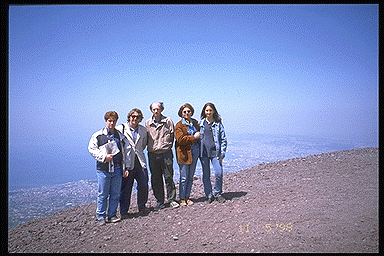 In 1998 Ron Norland from Newsweek Magazine came to the Vesuvius
area and was guided to the crater by Flavio Dobran, Ida Mascolo, and some
students from I.T.C. Sturzo (Castellammare di Stabia). The view is towards
Naples.
In 1998 Ron Norland from Newsweek Magazine came to the Vesuvius
area and was guided to the crater by Flavio Dobran, Ida Mascolo, and some
students from I.T.C. Sturzo (Castellammare di Stabia). The view is towards
Naples.
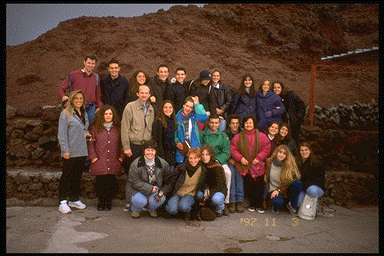 Students from Liceo Plinio Seniore (Castellammare di Stabia)
photographed in 1997 at the top of the crater. Their teacher, Lina Costanzo,
on the right wears a red coat
Students from Liceo Plinio Seniore (Castellammare di Stabia)
photographed in 1997 at the top of the crater. Their teacher, Lina Costanzo,
on the right wears a red coat
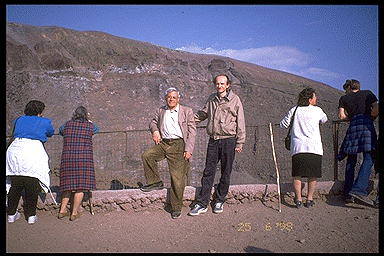 Giorgio (on the left) was born in Torre del Greco and vividly remembers
the last eruption in 1944. He is well educated about the possible
consequences of an eruption and says that he will leave for Sardenia at the
first signs of the unrest of Vesuvius.
Giorgio (on the left) was born in Torre del Greco and vividly remembers
the last eruption in 1944. He is well educated about the possible
consequences of an eruption and says that he will leave for Sardenia at the
first signs of the unrest of Vesuvius.
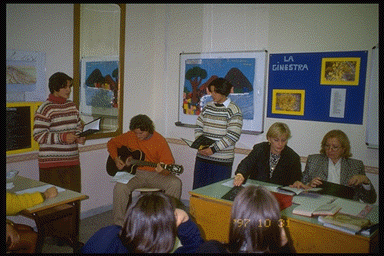 Rosi Linda from S.M.S. Colamarino (Torre del
Greco) and Anna Ibello from S.M.S. Don L. Milani (Portici) are seated in
front of their students during the visit of the New York Times
Television in 1997. This program is being shown on the learning channel in
the
United States.
Rosi Linda from S.M.S. Colamarino (Torre del
Greco) and Anna Ibello from S.M.S. Don L. Milani (Portici) are seated in
front of their students during the visit of the New York Times
Television in 1997. This program is being shown on the learning channel in
the
United States.
Main Selection?
 Vesuvius is surrounded by about 3 million people, which includes about
one million living in the city of Naples. Naples is also surrounded by
the
Phlegrean Fields on the west which pose another volcanic treat.
Vesuvius is surrounded by about 3 million people, which includes about
one million living in the city of Naples. Naples is also surrounded by
the
Phlegrean Fields on the west which pose another volcanic treat.
 Via Liberta in Portici is only 5 kilometers from the crater of
Vesuvius, with
the population density of about 15,000 inhabitants per square kilometer.
In the event of an emergency people will most likely panic because they
will feel of being trapped.
Via Liberta in Portici is only 5 kilometers from the crater of
Vesuvius, with
the population density of about 15,000 inhabitants per square kilometer.
In the event of an emergency people will most likely panic because they
will feel of being trapped.
 The family Bronzuto lives in Ercolano and from their terrace have a
splendid
view of the volcano. There are many buildings like this one abusively
constructed by speculators too close to the volcano.
The family Bronzuto lives in Ercolano and from their terrace have a
splendid
view of the volcano. There are many buildings like this one abusively
constructed by speculators too close to the volcano.
 Torre del Greco is the largest city of the Vesuvius area, with about 104,000
inhabitants. It was destroyed several times after the Pompeii eruption in
79 and the last time in 1794 when the lava flow reached the sea, 7
kilometers from the crater. The town shown in the background was built
on this lava after 1794.
Torre del Greco is the largest city of the Vesuvius area, with about 104,000
inhabitants. It was destroyed several times after the Pompeii eruption in
79 and the last time in 1794 when the lava flow reached the sea, 7
kilometers from the crater. The town shown in the background was built
on this lava after 1794.
 Herculaneum was covered with more than 10 meters of pyroclastic debris
during the 79 eruption. About 5,000 people lived in this resort town and
most apparently escaped. The town was rediscovered by chance in 1711,
but it was not until 1738 that the Bourbon King Charles II initiated the
excavation. The view from the sea shows that some part of the town is still
buried under the modern town of Ercolano (white buildings in the
background).
Herculaneum was covered with more than 10 meters of pyroclastic debris
during the 79 eruption. About 5,000 people lived in this resort town and
most apparently escaped. The town was rediscovered by chance in 1711,
but it was not until 1738 that the Bourbon King Charles II initiated the
excavation. The view from the sea shows that some part of the town is still
buried under the modern town of Ercolano (white buildings in the
background).
 The Greco-Roman town of Pompeii was buried under several meters of
pyroclastic flows and tephra during the 79 eruption. It too was
rediscovered by chance and Charles II ordered excavations in 1748, when
it became hard to loot for treasure in the ruins of Herculaneum. Pompeii
was a very prosperous commercial town of about 20,000 people where
many Romans adopted the
Greek culture. This view of Vesuvius was taken from the ruins of the
forum.
The Greco-Roman town of Pompeii was buried under several meters of
pyroclastic flows and tephra during the 79 eruption. It too was
rediscovered by chance and Charles II ordered excavations in 1748, when
it became hard to loot for treasure in the ruins of Herculaneum. Pompeii
was a very prosperous commercial town of about 20,000 people where
many Romans adopted the
Greek culture. This view of Vesuvius was taken from the ruins of the
forum.
 In 1994 the crew of Scientific American Frontiers (host Allen Alda) came to
film our Vesuvius activities. This picture with Allen was taken on the edge
of the southern crater rim of the volcano. The view is towards Torre
Annunziata and the sea.
In 1994 the crew of Scientific American Frontiers (host Allen Alda) came to
film our Vesuvius activities. This picture with Allen was taken on the edge
of the southern crater rim of the volcano. The view is towards Torre
Annunziata and the sea.
 The Canadian Broadcasting Company, Societe' Radio Canada, came to film
GVES activities in the Vesuvius area and produced a 15-minute
documentary called "Le Vesuve"
for world-wide distribution. Shown in this picture are Flavio Dobran and
Giuseppe Luongo with the television crew on Vesuvius.
The Canadian Broadcasting Company, Societe' Radio Canada, came to film
GVES activities in the Vesuvius area and produced a 15-minute
documentary called "Le Vesuve"
for world-wide distribution. Shown in this picture are Flavio Dobran and
Giuseppe Luongo with the television crew on Vesuvius.
 In 1998 Ron Norland from Newsweek Magazine came to the Vesuvius
area and was guided to the crater by Flavio Dobran, Ida Mascolo, and some
students from I.T.C. Sturzo (Castellammare di Stabia). The view is towards
Naples.
In 1998 Ron Norland from Newsweek Magazine came to the Vesuvius
area and was guided to the crater by Flavio Dobran, Ida Mascolo, and some
students from I.T.C. Sturzo (Castellammare di Stabia). The view is towards
Naples.
 Students from Liceo Plinio Seniore (Castellammare di Stabia)
photographed in 1997 at the top of the crater. Their teacher, Lina Costanzo,
on the right wears a red coat
Students from Liceo Plinio Seniore (Castellammare di Stabia)
photographed in 1997 at the top of the crater. Their teacher, Lina Costanzo,
on the right wears a red coat
 Giorgio (on the left) was born in Torre del Greco and vividly remembers
the last eruption in 1944. He is well educated about the possible
consequences of an eruption and says that he will leave for Sardenia at the
first signs of the unrest of Vesuvius.
Giorgio (on the left) was born in Torre del Greco and vividly remembers
the last eruption in 1944. He is well educated about the possible
consequences of an eruption and says that he will leave for Sardenia at the
first signs of the unrest of Vesuvius.
 Rosi Linda from S.M.S. Colamarino (Torre del
Greco) and Anna Ibello from S.M.S. Don L. Milani (Portici) are seated in
front of their students during the visit of the New York Times
Television in 1997. This program is being shown on the learning channel in
the
United States.
Rosi Linda from S.M.S. Colamarino (Torre del
Greco) and Anna Ibello from S.M.S. Don L. Milani (Portici) are seated in
front of their students during the visit of the New York Times
Television in 1997. This program is being shown on the learning channel in
the
United States.